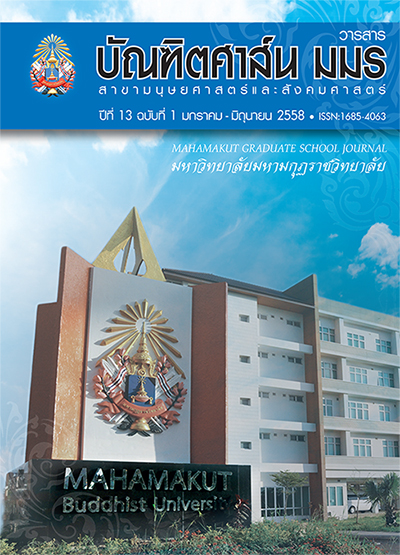India – Thailand Relations: And Cultural Links in Soft Power Policy
คำสำคัญ:
Suvarnabhumi, Dvaravati, Buddhism, Brahmanism, Religious links, cultural links, Look East Policy, Look West Policy, BIMSTEC, Mekong Ganga Cooperation (MCG).บทคัดย่อ
The article will explore the religious and cultural ties between India and Thailand since the ancient time. The relations in terms of religious and cultural ties had promoted relations that contributed to the concept of soft power which is the popular concept in international politics. It will also examine the ‘Look East Policy’ and ‘Look West Policy’, and how the two Policies ‘remarriage’ in order to promote ‘people to people’ and tourism destination under the broad domain of the two mechanisms: The Bay of Bengal Initiative for Multi-Sectoral Technical and Economic Cooperation (BIMSTEC) and Mekong Ganga Cooperation (MCG) work to promote the role of religion and culture in India-Thai Relations in the modern period.
เอกสารอ้างอิง
(2) Buddhadas, (1990), The Discourse on Phra Gun Thi India Me To Thai or India’s Benevolence to Thailand, translated into Thai by Karuna Kusalasaya, Bangkok, Thai-Bharat Cultural Lodge.
(3) Carr,E.H.(1964), first edition 1939, The twenty year’s crisis,1919-1939 : An introduction to the study of international relations, NY, Harper&Row.
(4) Jha Ganganath Jha, (2006), “Indo-Thai Relations in the Twenty Century”, Quoted from Sachchidanand Sahai and Neeru Misra, (ed), in Mapping Connections Indo-Thai Historical and Cultural Linkages New Delhi,Montra Books.
(5) Kaul, Manmohani,(2006), :Regional Groupings:An Overview of BIMSTEC and MGC”, South Asian Survey.
(6) Naidu G.V.C, (2004) “Whither the Look East Policy : India and Southeast Asia”, Strategic Analysis, Vol.28, No.2 Apr-Jun, p.344.
(7) Naidu,GVC,(2008) “BIMSTEC and its geo-strategic importance”, New Delhi, World Focus P.22
(8) Nye, J.S,(2004a).Soft power: the means to success in world politics, NY, Public Affairs.
(9) Nye, J.S,(,(2002).The Paradox of American Power : why the world’s only superpower cant’t go it alone. Oxford University Press.Inc.
(10) Mishra Patit Paban, (2005), Cultural Rapprochement between India and Southeast Asia, New Delhi, National Book Organisation.
(11) Phasook Indrawooth, (2007), “Dvaravati : Early Buddhist Kingdom in Central Thailand” in Neeru Misra and Sachchidanand Sahain (ed), Indo-Thai historical and Cultural linkages, New Delhi,Manohar.
(12) Raven, B.and French, J.R.(1959),the basis of social power, in Studies in Social power, edited by Cartwright,D.P.MI: Institute for Social Research, University of Michigan.
(13) Ray Himanshu Prabha, (2008), Emblems of the Indian Republic: Uncovering the modern history of Buddhsim in South Asia, Quoted from Phuangkasem Corrine, Reflections on Indo-Thai Historical and contemporary Cultural Relations, Bangkok, Thammasat University.
(14) Robert A.Dahal A,(1957),2001 ”The Concept of Power./Behavior Science“, 2:3, July, p.201. Sahai Sachchidanand, Misra Neeru, (2006), Mapping Connections Indo-Thai Historical and Culture Lingkages, Mantra Book, New Delhi.
(15) Sing,Swarn(2007) “Mekhong-Ganga Cooperation Initiatives : Analysis and Assessment of India’s Engagement with Greater Mekhong-Sub-region”, The Irasec Occasional Paper.
(16) Tharoor,Shashi, (2008) “India as a Soft Power” India International Centre Quarterly, India International Centre, Vol35, No.1p. 42
ดาวน์โหลด
เผยแพร่แล้ว
รูปแบบการอ้างอิง
ฉบับ
ประเภทบทความ
สัญญาอนุญาต
บทความวิชาการและบทความวิจัยในวารสารฉบับนี้ถือเป็นความรับผิดชอบของผู้เขียนเท่านั้น บทความที่ได้รับการตีพิมพ์ในวารสารบัณฑิตศาส์น ถือเป็นลิขสิทธิ์ของมหาวิทยาลัยมหามกุฏราชวิทยาลัย ตามพระราชบัญญัติลิขสิทธิ์



